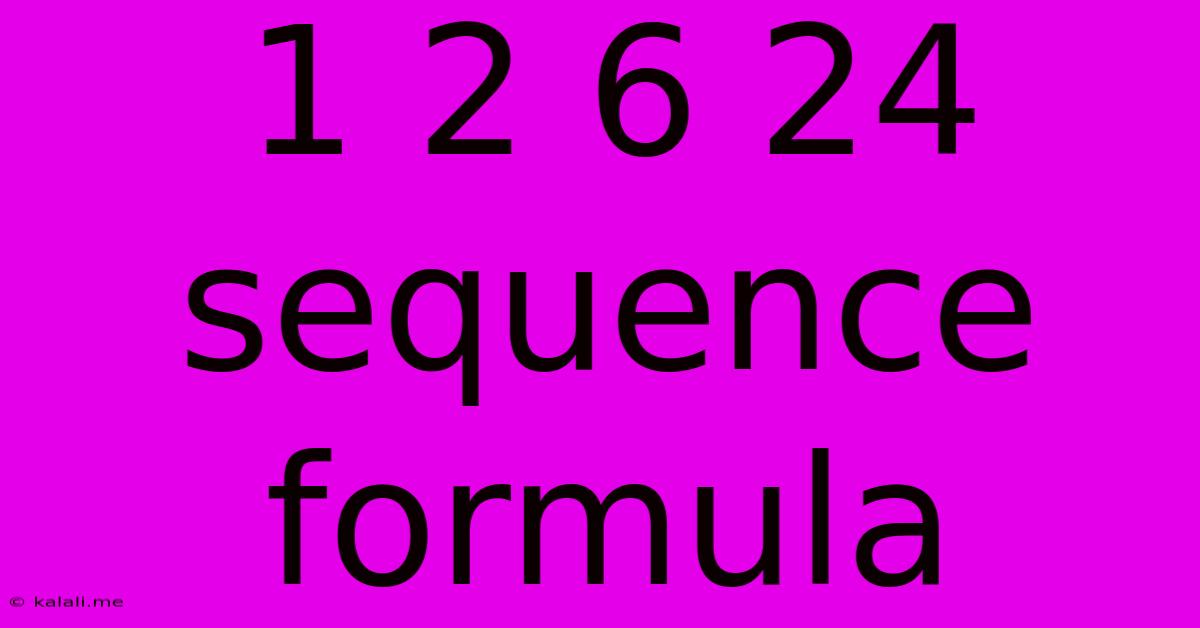1 2 6 24 Sequence Formula
Kalali
Jun 04, 2025 · 3 min read

Table of Contents
Decoding the 1, 2, 6, 24 Sequence: Unveiling the Formula and its Mathematical Beauty
This article delves into the fascinating mathematical sequence: 1, 2, 6, 24... Understanding its underlying formula isn't just about finding the next number; it's about grasping the elegance of mathematical patterns and applying this knowledge to more complex problems. We'll explore different approaches to identifying the formula, highlighting the power of observation and logical deduction.
What makes this sequence unique? At first glance, the sequence might seem random. However, a closer look reveals a pattern based on multiplication, specifically involving factorials. This is a crucial element in understanding its progression and predicting future numbers. We'll explore how the factorial function relates to this sequence and discuss the significance of this relationship in mathematical contexts.
Identifying the Pattern: The Factorial Connection
The key to unlocking the formula lies in recognizing the factorial function (!). The factorial of a non-negative integer n, denoted by n!, is the product of all positive integers less than or equal to n. For example:
- 1! = 1
- 2! = 2 x 1 = 2
- 3! = 3 x 2 x 1 = 6
- 4! = 4 x 3 x 2 x 1 = 24
Notice a striking similarity? Each number in the sequence (1, 2, 6, 24) corresponds to the factorial of its position in the sequence:
- 1st number: 1! = 1
- 2nd number: 2! = 2
- 3rd number: 3! = 6
- 4th number: 4! = 24
This direct correlation establishes the formula: The nth number in the sequence is equal to n!.
Extending the Sequence and Applying the Formula
Now that we've identified the formula, we can easily predict future numbers in the sequence. For example, the 5th number would be 5! = 5 x 4 x 3 x 2 x 1 = 120. The 6th number would be 6! = 720, and so on. This showcases the predictive power of understanding the underlying mathematical structure.
Beyond the Sequence: Applications of Factorials
The factorial function isn't just limited to this specific sequence; it has wide-ranging applications in various mathematical fields, including:
- Combinatorics and Permutations: Factorials are fundamental in calculating the number of ways to arrange items or select subsets from a larger set. This is crucial in probability and statistics.
- Calculus: Factorials appear in Taylor and Maclaurin series expansions, which are essential tools for approximating functions.
- Probability Distributions: The factorial function is integral to several probability distributions like the Poisson distribution and the binomial distribution.
Conclusion: The Power of Pattern Recognition
This exploration of the 1, 2, 6, 24 sequence demonstrates the power of observation and pattern recognition in mathematics. By identifying the underlying factorial relationship, we not only deciphered the sequence's formula but also gained insight into the broader applications of factorials within mathematics and beyond. This example highlights the importance of looking beyond the surface of a problem to uncover its elegant and often surprising mathematical structure. Understanding the fundamental principles behind sequences like this allows us to solve more complex problems and appreciate the intricate beauty of mathematics.
Latest Posts
Latest Posts
-
There Is A Beast Beneath The Boards
Jun 06, 2025
-
Building A Level Concrete Slab On A Slope
Jun 06, 2025
-
What Can I Use As A Mousepad
Jun 06, 2025
-
Cat Poops In Litter Box But Pees On Floor
Jun 06, 2025
-
Max Wattage To Charge Macbook Pro
Jun 06, 2025
Related Post
Thank you for visiting our website which covers about 1 2 6 24 Sequence Formula . We hope the information provided has been useful to you. Feel free to contact us if you have any questions or need further assistance. See you next time and don't miss to bookmark.